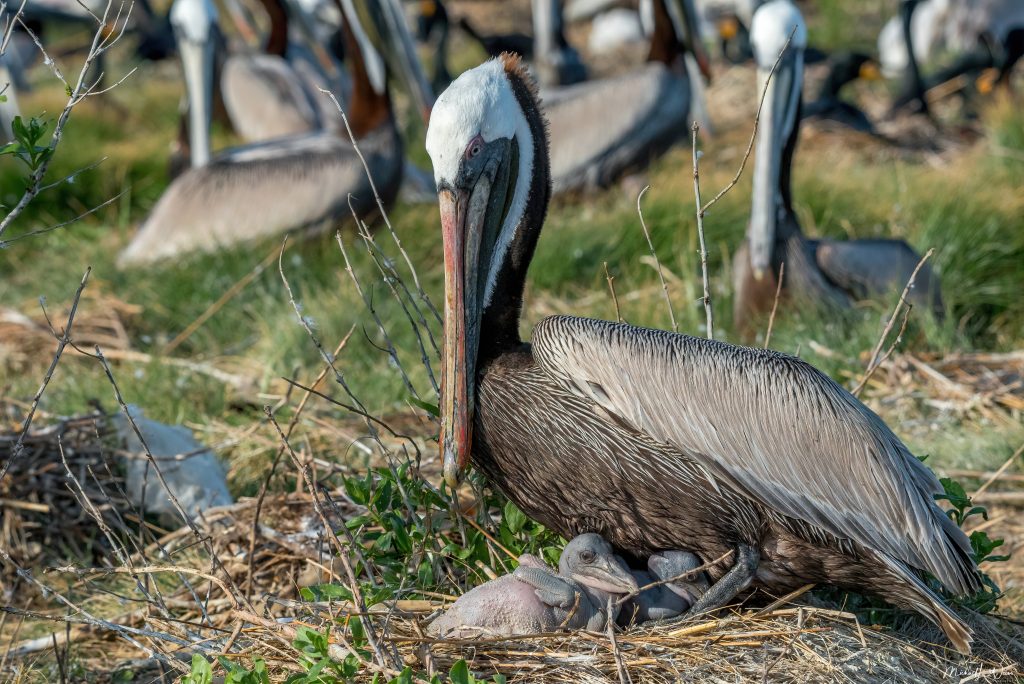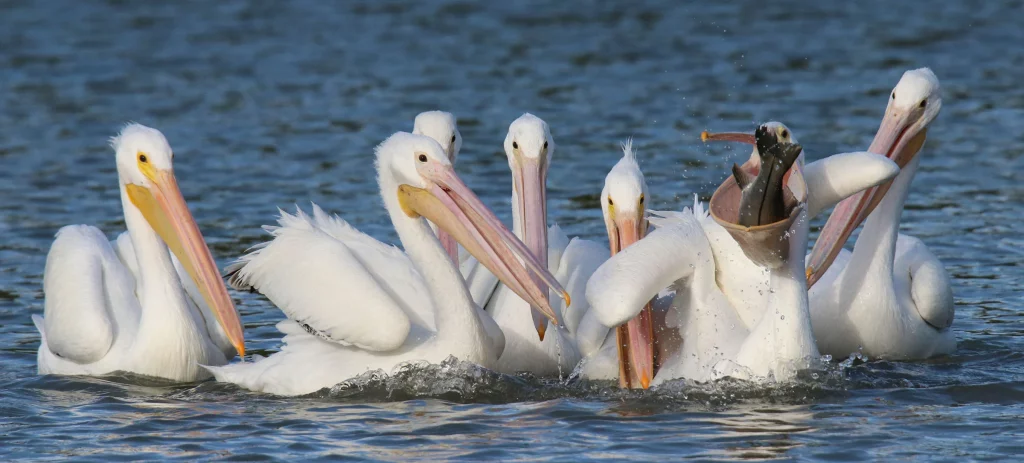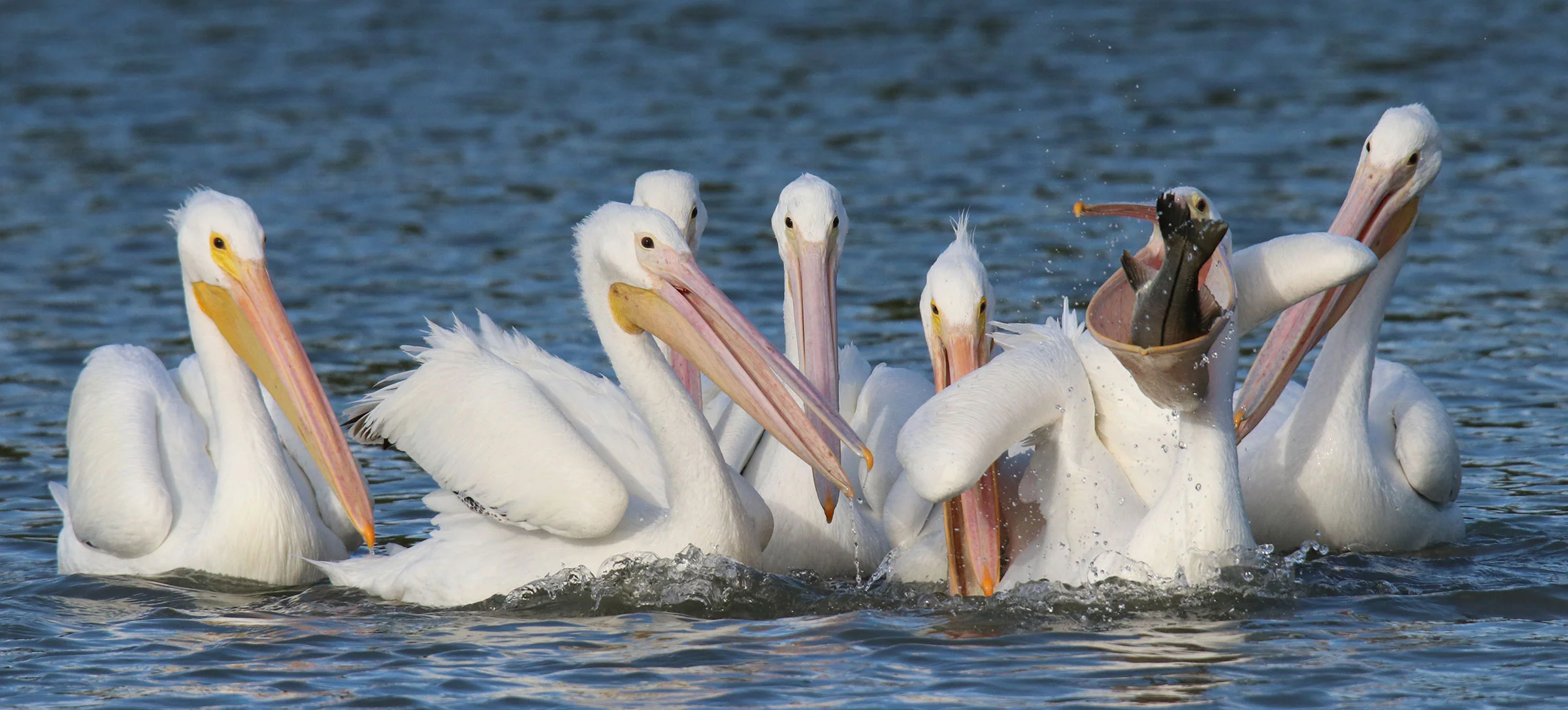In Maryland, you can come across both the Brown Pelican and the American White Pelican, which are two species of pelicans found in North America.
During the summer, it is possible to spot the Brown Pelican in this region, although sightings of the American White Pelican are rare and infrequent.
Pelicans are globally recognized as one of the largest bird species, distinguished by their enormous bills, expandable throat pouches, and sturdy feet. Despite their large size, they possess remarkable lightness, thanks to air-filled pockets in their skeleton and skin, enabling them to float effortlessly. Furthermore, their elongated wings facilitate graceful soaring during flight.
In the world, there exist a total of eight pelican species, with two of them residing in North America, namely the American White Pelican and the Brown Pelican.
During the breeding season, pelicans undergo remarkable transformations. Their facial skin, throats, and bills become vividly colored, and some even develop additional structures on their bills.
Pelicans exhibit a colonial breeding behavior, with colonies consisting of up to 50,000 birds. Depending on the species, these colonies can either nest on the ground or in trees. After approximately 25 days in the nest, the young pelicans gather in groups called “creches,” comprising up to 100 individuals. Astonishingly, the parents possess the ability to recognize their own offspring and solely provide them with food.
Although pelicans are known to prey on various animals, they are not classified as birds of prey, a distinction reserved for raptors. The primary diet of pelicans comprises fish, but they also consume crabs, frogs, snakes, mammals, birds, and insects.
The distinctive throat pouch of pelicans aids them in capturing fish and draining the water before swallowing. In the case of young pelicans, they directly feed from their parents’ throat pouches.
To assist in identifying the different types of pelicans spotted in Maryland, this guide relies on data collected from birdwatchers on eBird and utilizes information from avibase to provide accurate and reliable information regarding the presence of these birds.
Maryland is home to two species of pelicans:
1. Brown Pelican

Brown Pelicans have been observed throughout the year in Maryland, but they are most prevalent in the southern part of the state between April and December.
Adult non-breeding Brown Pelicans typically possess white heads and necks, along with pale yellow foreheads. Their elongated bills display a combination of yellow and orange hues. The body of these pelicans exhibits a grayish-brown coloration, accompanied by short black legs and webbed feet. Juvenile Brown Pelicans display brown heads, necks, backs, and wings, with bluish-gray bills and a light brown underside.
The Brown Pelican species encompasses five subspecies, two of which breed within the United States. The Pacific Coast variant is referred to as P.o.californicus, while the Atlantic Coast variant is known as P.o.carolinensis.
The differences between Pacific and Atlantic Brown Pelicans become more apparent during the breeding season. Both species develop white heads with brighter yellow foreheads. The napes of their necks transition from white to dark brown. Atlantic Brown Pelicans possess olive-brown throat pouches, while Pacific Brown Pelicans exhibit red skin on their throat pouches.
Pelecanus occidentalis
Length: 48 – 50 inches (122 – 127 cm)
Weight: 131.2 ounces (3718 g)
Wingspan: 78 – 84 inches (198 – 213 cm)
Brown Pelicans either breed and migrate or reside year-round along the Pacific and Atlantic Coasts of North America, extending down to northern South America.
Brown Pelicans tend to inhabit shallow water environments. They are
permanent residents in estuaries, coastal marine habitats, and mangrove islets. Additionally, they can be found resting on sandbars, breakwaters, and offshore rocks.
Notably, Brown Pelicans possess a remarkable foraging ability that sets them apart. They are capable of diving into deep ocean waters to capture their prey within their throat pouches. Upon resurfacing, they expel the water, enabling them to promptly consume their catch.
Their diet primarily consists of fish such as sardines and herring. While not diving, they casually swim and seize prey with their bills. They may also consume crustaceans like crabs, amphibians, eggs, and other young birds.
Regarding vocalizations, adult Brown Pelicans are generally silent, occasionally emitting a grunt. However, juvenile pelicans may squawk to solicit food.
Brown Pelican nests are predominantly constructed on the ground, rather than in trees. They seek concealment and protection on islands, mangroves, and cliffs. The female pelican builds the nest using materials such as reeds, leaves, pebbles, sticks, and soil. She lays two to four eggs, which are incubated by both parents for approximately one month.
Fun Fact: Brown Pelicans incubate their eggs by covering them with their webbed feet. This behavior had detrimental consequences for the species when the pesticide DDT led to the thinning of eggshells, causing them to break under the weight of the parent’s feet. Extensive conservation efforts were necessary to restore the Brown Pelican population.
2. American White Pelican

American White Pelicans are considered rare or accidental in Maryland, and while sightings have occurred throughout the year, they are primarily observed during winter, from November to March, in the southern part of the state.
American White Pelicans are majestic birds that soar through the air, boasting the second-largest average wingspan among North American avian species.
Non-breeding adult American White Pelicans exhibit a white plumage across their entire body, except for black flight feathers, visible during flight or when their wings are extended. They possess bluish-gray eyes and yellow facial skin surrounding their eyes. Their bills, pouches, and feet display a pale orange coloration. Juvenile American White Pelicans have light gray feathers with darker brown napes.
Breeding adult American White Pelicans exhibit distinct coloration compared to non-breeding individuals. They develop a yellow plate on their upper bills, reminiscent of a horn. While their bodies retain their white appearance, their eyes, bills, legs, and feet become a brighter shade of orange.
American White Pelicans undergo several molting changes, commonly referred to as eclipse. During spring, they exhibit a visible yellowish patch on their breast and chest. In summer, their heads acquire blackish feathers.
- Pelecanus erythrorhynchos
- Length: 60 – 63 inches (152 – 160 cm)
- Weight: 246.4 ounces (6983 g)
- Wingspan: 96 – 110 inches (244 – 279 cm)
American White Pelicans breed in remote inland lakes within North America, subsequently spending their winters along the southern Pacific Coast of the United States, the Gulf of Mexico, Mexico, and Central America. They can be observed during migration in western and central U.S. states.
Shallow freshwater lakes, wetlands, and the edges of lakes and rivers serve as habitats for American White Pelicans. During winter, they can be found in coastal bays, inlets, and estuaries, where they forage in shallow water and rest on sandbars.
The primary food source for American White Pelicans is fish. They glide on the water surface, capturing their prey with their massive bills. They also engage in cooperative foraging with other
bird species, employing strategic and coordinated efforts to drive fish toward the shore, making it easier for them to scoop up their meal.
American White Pelicans display opportunistic feeding behaviors and are willing to travel significant distances in search of better feeding grounds. Additionally, they may consume crayfish, amphibians, salamanders, and are known to steal fish from other birds on the water’s surface.
When it comes to vocalizations, American White Pelicans are generally silent, emitting only a few grunts. However, their young can be quite noisy within large colonies as they beg for food.
American White Pelican nests consist of simple, shallow depressions on the ground. Twigs, sticks, reeds, and other materials are added to provide additional protection for the eggs.
The female pelican lays one to two eggs, which both parents incubate for up to thirty-six days. Unfortunately, due to siblicide, a phenomenon where one sibling kills the other, only one chick per nest typically survives.
Fun Fact: The elongated and substantial bill of the American White Pelican has the capacity to hold up to three gallons of water. When capturing fish, the pelican tilts its bill downward to drain the water, allowing it to swallow the remaining fish within its throat sac.
